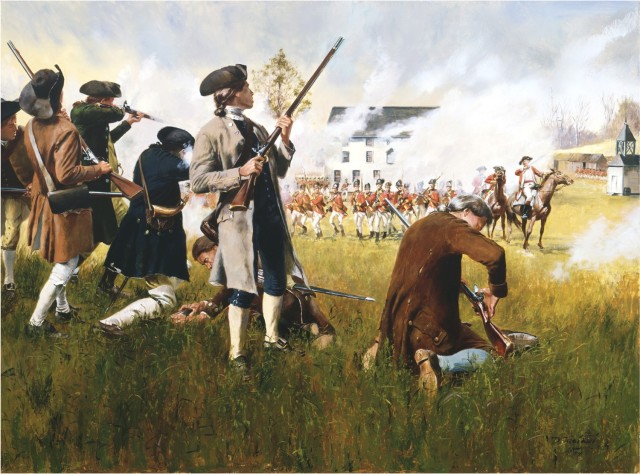
“Shot Heard ‘Round the World,” that started the Revolutionary War. In 1875, on the 100th anniversary of the action at Concord, Daniel Chester French’s Minuteman statue, the symbol of today’s National Guard, was dedicated. Today’s National Guard is the direct descendent of those militia and Minute Men who stood their ground to protect their homes and freedoms.
VIEW ORIGINAL
WASHIONGTON — The actions of future Army National Guard units at North Bridge, Concord, Massachusetts, April 19, 1775, shaped the course of American and world history.
Sons of Liberty
In October 1774, British Commander in Chief in North America Lt. Gen. Thomas Gage dissolved the Massachusetts Assembly by order of King George III. Continuing to meet as the Massachusetts Provincial Congress, the assembly acted as a shadow government for the colony.
On April 15, 1775, in Boston, Gage organized a task force of about 700 soldiers under the command of Lt. Col. Francis Smith to fulfill the Crown’s order to use military force to solve the political crisis.
Gage meant to demonstrate imperial British power by making a secret strike at Concord to seize and destroy military supplies. The Sons of Liberty in Boston became aware of the details of the expedition.
Following critical readiness and logistics reforms to the militia in the Fall of 1774, the Massachusetts Provincial Congress organized nearly 20,000 troops into county militia regiments. One in four troops were minutemen in special minute battalions which maintained higher standards of readiness.
Battle of Lexington
They were prepared for just such an incursion. A showdown between militia and regulars had taken place in Salem in February 1775. Although there were harsh words, no shots were exchanged.
After 1 a.m. on April 19, Smith’s column left Boston and proceeded toward Concord by way of Lexington.
Having triggered the colony’s alert system, the British found the countryside in arms.
Capt. John Parker’s Lexington militia company was arrayed on the village green when the Regulars entered the town on the road to Concord.
Rather than following the road, British infantry entered the line of battle and confronted the militia, ordering them to disperse.
Before Parker could obey, someone fired a shot.
The British opened fire and charged. After a brief skirmish which killed eight militiamen, Smith got his men under control and pushed on to Concord, unaware that there were elements of 47 militia regiments — about 14,000 troops — within marching distance.

Militia Capt. John Parker mobilized the Lexington Company of the Middlesex, County Brigade, Massachusetts Militia, and ordered them to “Stand their ground” as they took on British forces during the Battle of Lexington and Concord Battle. This battle led to the Revolutionary War and American independence. The Lexington Company and the Middlesex County Brigade are perpetuated by the 181st and 182nd Infantry Regiments, Massachusetts Army National Guard. April 19, 1775.
VIEW ORIGINAL
Battle of Concord
Hearing of the clash at Lexington, Concord’s Col. John Barrett mustered his militia regiment and those of the town’s minute battalion, temporarily led by Maj. John Buttrick.
Choosing not to contest the town, they withdrew to higher ground overlooking the North Bridge on the Sudbury River as Smith’s redcoats entered Concord.
Smith deployed companies of light infantry to defend the approaches to the town as his grenadiers searched for military stores. Three companies of light infantry guarded North Bridge, keeping a wary eye on the growing mass of militia on the hill nearby.
At around 10 a.m. April 19, Barrett and Buttrick had nearly 500 troops assembled, just as smoke from burning supplies began to rise from Concord.
Thinking the British were torching the town, Barrett ordered Buttrick to lead a column of about 250 men toward the bridge, with the injunction that they were not to fire first.
As the column approached, the British companies retired to the east side of the bridge and began pulling up the planks. When the lead minute company under Capt. Isaac Davis of Acton was within 40 yards, the British fired a volley, killing Davis and a private.
“Fire, fellow soldiers, for God’s sake, fire!” ordered Maj. Buttrick, and the militia delivered a lethal volley into the British ranks — later to be known as, “the shot heard ‘round the world.”
After several minutes of chaotic firing, the British broke and ran toward Concord.
Back to Boston
With enraged militia closing in on all sides, Smith consolidated his troops and hurried the march back to Boston.
Militia companies caught his column in ambushes at places like Meriam’s Corner, Hardys Hill, Bloody Angle, and Parker’s Revenge. Only a rescue force which met Smith’s command in Lexington saved it from destruction.
Fighting raged throughout the day as the British struggled back to Boston.
Combat in modern-day Arlington left houses burnt and the dead laying in heaps from hand-to-hand fighting. The British force staggered back into Charlestown under the protecting guns of the Royal Navy by nightfall.
The Massachusetts forces began to lay siege to Boston. Seventy-three British soldiers and around 50 militiamen were dead, with the wounded numbering in the hundreds. Massachusetts appealed to the other colonies for aid, and regiments arrived from around New England to help over the coming weeks. Neither side then knew it, but the struggle for American independence had begun.
Thirty-four Army National Guard units and one Regular Army unit carry their lineage back to the Revolutionary War. The 101st Field Artillery, 101st Engineer Battalion, 181st Infantry, 182nd Infantry, and 125th Quartermaster Company carry the Lexington streamer for April 19, 1775.
This "National Guard units trace history to battles of Lexington, Concord" was originally found on https://www.army.mil/rss/static/380.xml

